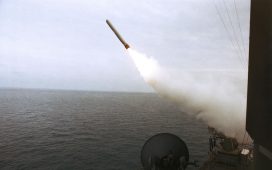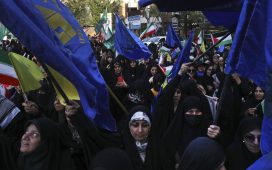To the north of Gaza’s Beit Lahia, before the border wall with Israel is reached, lies an area of agricultural land and villages that curls around the tip of the coastal strip. In times of conflict, its fields and scattered houses are a very dangerous place.
Close to one of the main entry points used for invading by Israeli forces, and vulnerable to bombs and artillery, it is also used as a line of defence by Gaza’s militant fighters.

Hussein Abu Qleeq, who lives in a Bedouin village close to the border, was in his three-storey home when it was hit. “I was sitting with my family,” the 30-year-old told the Guardian in the Shifa hospital in Gaza city.
“Suddenly, there was a sound of intense artillery shelling on the border. I didn’t expect it to hit the houses. Children started screaming. Then a shell came into our house.”
Hussein was hit by shrapnel in his neck, arm and back. “It was a terrifying atmosphere. You can’t imagine it. We have lived through three wars and this is the first time this bombing has happened in such a sudden, violent way.”

In the past, as those like Hussein know from personal experience, the Israeli military has warned residents of such outlying rural areas to vacate their homes before operations.
But this time, they suggest, no warning was given by the Israeli military as it hit what it said were tunnels used by Hamas and Islamic Jihad in a bombardment that turned the night sky orange with huge fireballs as the barrage crept south.
Jonathan Conricus, an Israeli military spokesman, said Israeli forces took care with their targets but were not always able to give warning to residents. “As always, the aim is to strike military targets and to minimise collateral damage and civilian casualties,” Conricus said, according to the Associated Press. “Unlike our very elaborate efforts to clear civilian areas before we strike high-rise or large buildings inside Gaza, that wasn’t feasible this time.”
Taher al-Kafarneh, aged 68, who lives in the border area near the neighbouring town of Beit Hanoun, tells a similar story to Hussein Abu Qleeq.

“When the violence started to escalate, I moved with my 15 sons, my two wives and my grandchildren to my daughter’s house in the centre of Beit Hanoun, into one house consisting of three floors, with about 150 people [sheltering there].
“At about midnight, the intense bombardment began with rockets from each side in addition to artillery, and the street was bombed with violent and continuous missiles. A shell from a plane or artillery … I don’t know … hit the last floor of the house in which some of my children and their children stayed, and the electricity of the house was cut off.
“Everyone was screaming. About 40 to 50 people from the house were injured from the bombing, and we escaped on foot, until ambulances arrived. Even then they could not reach the house because of bombing in the street. So people started carrying the injured.”
By Friday morning Palestinians living on Gaza’s northern and eastern fringes with Israel, were fleeing towards more heavily built-up areas in the Strip’s centre, escaping the intense artillery bombardment and fearing new barrages.
As families arrived at the UN-run schools in the city, used in wartime to house those escaping or whose houses have been destroyed, they came in pickup trucks, on donkeys and by foot, hauling pillows and pans, blankets and bread.
“We were planning to leave our homes at night, but Israeli jets bombarded us so we had to wait until the morning,” said Hedaia Maarouf, who fled with her extended family of 19 people, including 13 children. “We were terrified for our children, who were screaming and shaking.”

The main hospitals serving the north and centre have also seen a steady influx of dead and injured from these areas as Israel’s military campaign has moved from one of almost constant airstrikes against Hamas and Islamic Jihad towards artillery fire – which many fear may signal a ground invasion.
Already struggling with the coronavirus pandemic, hospitals across the crowded coastal enclave are reallocating intensive beds and scrambling to keep up with a very different health crisis: treating blast and shrapnel wounds, bandaging cuts and performing amputations.
Distraught relatives didn’t wait for ambulances, rushing the wounded by car or on foot to Shifa hospital, the territory’s largest. Exhausted doctors hurried from patient to patient, frantically bandaging shrapnel wounds to stop the bleeding. Others gathered at the hospital morgue, waiting with stretchers to remove the bodies for burial.
“Before the military attacks, we had major shortages and could barely manage with the second [virus] wave,” said Gaza health ministry official Abdelatif al-Hajj by phone, as bombs thundered in the background. “Now casualties are coming from all directions, really critical casualties. I fear a total collapse.”
Nurses at the European hospital in the southern town of Khan Younis, frantically searching for room for the wounded, moved dozens of virus patients in the middle of the night to a different building, said hospital director Yousef al-Akkad. Its surgeons and specialists, who had deployed elsewhere for the virus, rushed back to treat head injuries, fractures and abdominal wounds.
If the conflict intensifies, the hospital won’t be able to care for virus patients, al-Akkad said.
“We have only 15 intensive care beds, and all I can do is pray,” he said, adding that because the hospital lacks surgical supplies and expertise, he’s already arranged to send one child to Egypt for reconstructive shoulder surgery.
“I pray these airstrikes will stop soon.”
Associated Press and Reuters contributed to this article







